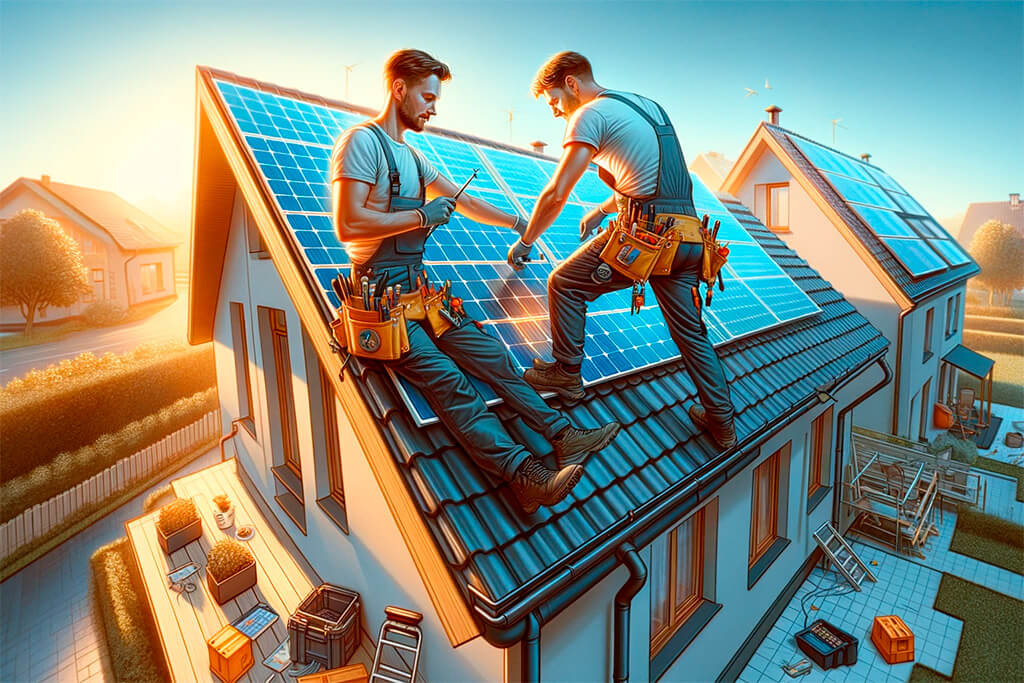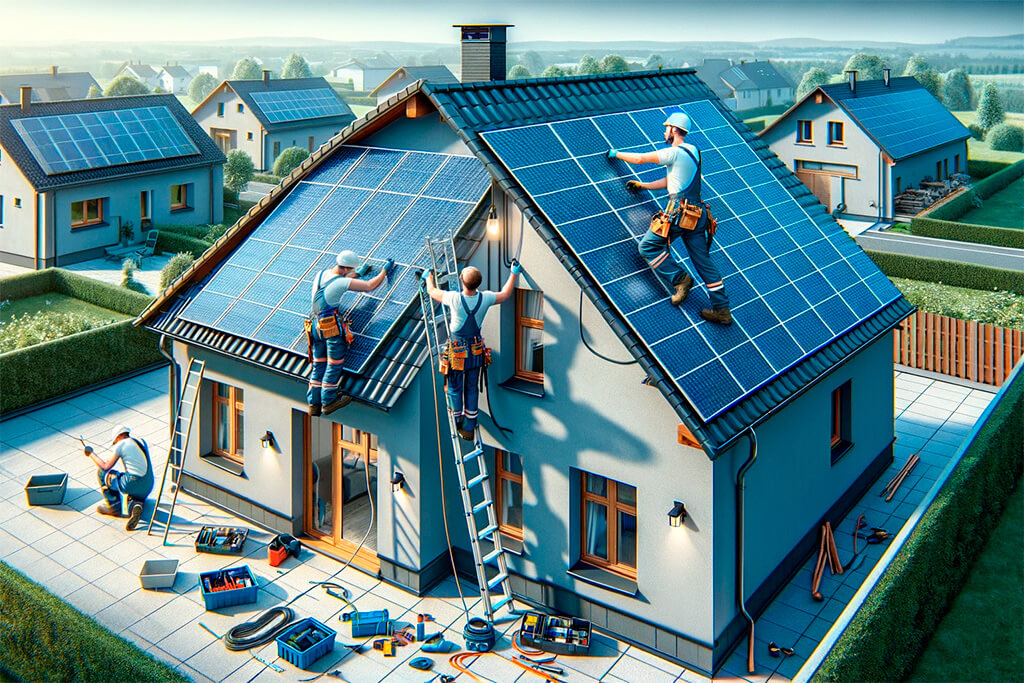In the realm of home improvement, solar panels have emerged as a key player, not just for their environmental appeal but for their practical, cost-saving benefits. These installations are a smart move for homeowners looking to cut down on energy costs and increase their property’s value. It’s a long-term investment with short-term gains.
This guide is tailored for the hands-on DIYers and independent contractors. It’s about empowering you with the knowledge and skills to tackle solar panel installation with confidence. Whether you’re a seasoned pro in construction or taking your first dive into a major home improvement project, you’ll find invaluable insights here.

Understanding Solar Panels
Solar panels, in their essence, are your personal mini power stations. They harness sunlight and transform it into electrical energy, a process that’s both fascinating and complex. Let’s break it down:
- Monocrystalline Panels: These are the cream of the crop, offering high efficiency in a compact form. They’re sleek, black, and carry a higher price tag, but they’re worth it for the power output, especially if your roof space is limited.
- Polycrystalline Panels: These panels, with their distinctive blue color, offer a balance between cost and efficiency. They’re ideal if you have more roof space and are looking for a cost-effective solution.
- Thin-Film Panels: The underdogs of the solar world, these panels are less efficient but highly adaptable. They’re great for unconventional surfaces and can withstand harsh weather conditions, but they’ll need more space to generate significant power.
The key here is to match the panel to your specific situation. It’s like choosing the right wood for a cabinet – you need to consider aesthetics, functionality, and durability.
Tools and Materials Needed
Now, let’s talk tools and materials. Here’s your essential checklist:
- Solar Panels: Your primary component.
- Mounting System: This includes all necessary racks and mounts, the backbone of your installation.
- Drill and Drill Bits: Quality is key here. You want tools that are reliable and precise.
- Wrenches and Screwdrivers: For tightening and securing every connection.
- Wire Strippers and Pliers: Essential for handling the electrical aspects safely and efficiently.
- Safety Equipment: Hard hats, safety glasses, gloves, and harnesses – non-negotiable for your safety.
Remember, each solar panel brand might have specific requirements or recommendations. It’s like following a recipe – the general steps might be the same, but the specifics can vary. Always cross-reference your materials list with the manufacturer’s guidelines to ensure you’re on the right track.
In our next section, we’ll delve into preparing your roof and the nitty-gritty of getting those panels up there, efficiently and safely. Stay tuned, and remember the golden rule: measure twice, cut once.
Preparation: Before You Begin
Before you dive into the world of solar panels, it’s crucial to do your homework. This step is like laying a strong foundation before building a house – it’s essential for success and longevity.
- Evaluating Your Roof:
- Assessing Strength and Condition: Just like checking the integrity of a floor before laying down new tiles, you need to ensure your roof can handle the load of solar panels. Look for any signs of damage or wear.
- Orientation and Shade: It’s about finding the sweet spot for sunlight exposure. A roof facing south (in the Northern Hemisphere) is usually your best bet. Be mindful of potential shade from trees or other structures, especially during peak sunlight hours.
- Measuring and Planning Layout: Think of this as sketching a blueprint before a build. Measure your roof to understand the available space and plan your solar panel layout accordingly. The goal is to utilize space efficiently while allowing for adequate airflow around the panels.
- Local Building Codes and Regulations: Navigating building codes and regulations is like understanding the rules of the game. Check with your local authorities to ensure your installation meets all the necessary requirements. This step can save you from future headaches and ensure your project is up to standard.

Step-by-Step Guide to Mounting Solar Panels
Now, let’s walk through the installation process, step by step. It’s like following a well-structured recipe – each step is crucial to the outcome.
- Setting up the Mounting System:
- Installing the Mounts: Just like laying a solid foundation for a house, securely anchor the mounts to your roof rafters. Use a stud finder to accurately locate the rafters.
- Optimal Angle: Adjusting the angle of your solar panels is akin to positioning a satellite dish, it needs to be precise for optimal performance. This angle will largely depend on your geographical location.
- Attaching Solar Panels to the Mounting System:
- Lifting the Panels: Handle the panels with care as you position them on the roof, much like handling a large glass pane during window installation.
- Securing the Panels: Bolt the panels onto the mounting system, ensuring they are aligned correctly. This step is like aligning bricks in a wall for both strength and aesthetics.
- Wiring and Connecting the Solar Panels:
- Handling the Electrical Work: This stage requires attention to detail, much like wiring a new room. Connect the panels to your power system, ensuring all connections are secure and insulated.
- Safety Checks: Double-check all electrical connections for safety, much as you would inspect a newly wired circuit.
Ensuring Durability and Weather Resistance
- Sealing Mounts: Apply sealant around the mounts to prevent water ingress, akin to caulking around a new window.
- Routine Inspections: Regularly inspect your installation, especially after extreme weather, much like you would check the integrity of a roof after a storm.
By following these steps carefully, much like following a thorough construction plan, your solar panel installation will be efficient, durable, and long-lasting.
Maintenance and Troubleshooting
Basic Maintenance Tips
To ensure your solar panels operate at their best, regular maintenance is key, much like keeping your gutters clean or your furnace serviced. Here’s what you should do:
- Regular Cleaning: Treat your solar panels like you would a prized window – keep them clean. Dust, leaves, and bird droppings can reduce efficiency. A gentle cleaning with a soft brush and mild detergent is usually sufficient.
- Visual Inspections: Like checking a roof for missing tiles after a storm, inspect your panels regularly for any damage, such as cracks or discoloration.
- Monitor Performance: Pay attention to the energy output. A noticeable decrease in performance could indicate an issue, akin to a furnace struggling to heat a home.
Common Issues and Troubleshooting
1. Reduced Power Output: This can be due to dirty panels or new shading, like a tree that’s grown taller. Cleaning or trimming might be required.
2. Electrical Problems: If you’re up for it, check the connections and wiring, similar to troubleshooting a home electrical issue. Otherwise, seek professional help.
3. Physical Damage: For any visible damage to the panels, it’s best to consult with a professional, just as you would for significant structural repairs on your home.
Conclusion
Like any significant home improvement project, the proper installation and maintenance of solar panels are crucial for their efficiency and longevity. It’s an investment in sustainable energy that not only benefits you financially but also contributes positively to environmental conservation. With the right approach, tools, and attention to detail, solar panels can be a valuable addition to your home, serving you for many years to come.
FAQ Section
The best roofs for solar panels are those that are sturdy, with minimal shading, and have a suitable pitch. Whether your roof is made of composite, metal, or tile, it’s the orientation and condition that matter most. Flat roofs may require angled mounting systems, while steep roofs need careful consideration for installation.
Proper alignment is to solar panels what a good foundation is to a house. The ideal angle depends on your latitude and can change with the seasons. There are tools and apps available that can help determine the best angle for your specific location.
Common mistakes include improper placement leading to shading, incorrect angling of panels, and poor electrical connections. It’s akin to the precision required in laying a foundation or framing a house. Following manufacturer instructions and adhering to local building codes are critical.
Yes, solar panels can be installed on ground mounts, which is similar to building a freestanding structure in your yard. This is a viable option if your roof isn’t suitable for solar panels. Ensure the ground mount is securely anchored and positioned for optimal sun exposure.
The installation time for solar panels can vary greatly, much like the difference between a kitchen remodel and a full home renovation. Smaller systems may take a day, while larger and more complex installations could take several days to a week.
